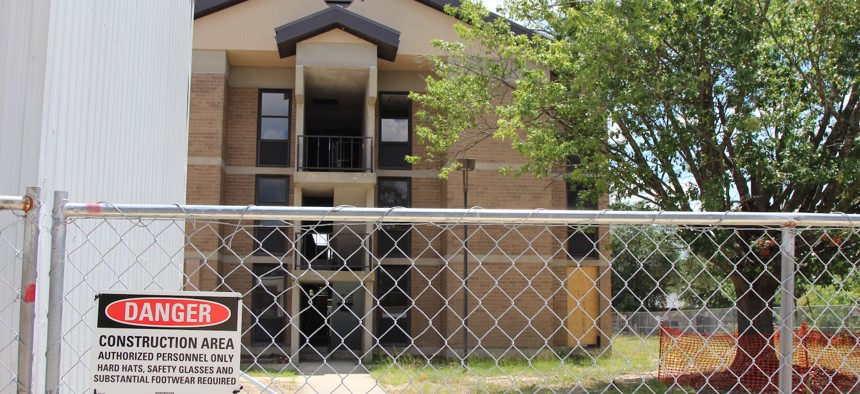
Barracks under renovation at Ft. Bragg, N.C. U.S. Army / Jason Ragucci
Army: Renovating Moldy Barracks is Just the Beginning of Prepping for Climate Change
While the Army works to improve and renovate facilities across the globe, it feels it’s built “solid” against climate impacts to come.
Army Materiel Command is working to preemptively protect its facilities against mold and climate change impacts, AMC’s deputy director for facilities, logistics, and environmental management Paul Schaefer told Defense One last week.
The Army in 2020 established its Facility Investment Plan as a way to streamline and standardize the process through which facilities were updated across the Army’s hundreds of installations. The program has allowed the Army to more effectively and uniformly keep buildings up to standards, officials said, which will become increasingly important as climate-change-driven natural disasters ramp up in the years to come.
“As extreme weather becomes commonplace, the Army must adapt its installations, acquisition programs, and training so that the Army can operate in this changing environment and reduce our greenhouse gas emissions,” Army Secretary Christine Wormuth said when the service released its climate implementation plan.
The facilities improvement program came about when the Army “realized we need to give our senior leaders a tool that is not as subjective,” Schaefer said. “History had shown that the squeaky wheel was getting the attention. We wanted to put together a deliberate process that’s repeatable and that’s defendable,” so that leaders could propose projects and AMC could award projects that aligned with the Army’s priorities.
“The FIP is the tool that will allow us to get after those most pressing needs in a timely manner,” he said.
For example, a standard FIP screening session identified problems at the Smoke Bomb Hill barracks at Fort Bragg, N.C.; the Army in September announced plans for a $115 million renovation of those facilities. The same phase of FIP screening also identified the need for a $59 million renovation of barracks at Fort Hood.
Both renovations could prevent bigger problems in the future, Schaefer said. And even those two large-scale projects leave $826 million for other barracks improvements in the service .
“The Army is committed to spending a billion dollars a year on the barracks,” Schaefer said, stressing that the dollar amount demonstrates how serious the Army is about putting people first and maintaining quality of life.
Schaefer was one of the senior officials that walked through Smoke Bomb Hill for the assessment, and said the Army “identified that the barracks, the HVAC systems, were not adequate enough. We identified that in order for our soldiers to remain safe, we needed to be proactive, and we moved the soldiers out before it became a safety issue.”
The Army is willing to “own up” to any problems identified, Schaefer said: “No one’s going to be perfect. But, by golly, we’re going to rectify it as soon as we can.”
The service has also been looking specifically at the ability of Army facilities to hold up against the impacts of climate change, Schaefer said, and so far, the data looks promising.
Some of the military’s installations are very old, Schaefer admitted. But overall, “we have built our facilities solid,” he said, and believes they have what it takes to “stand up to natural disasters.”
“We’re finding a lot of our facilities are going to bear just fine, outside of a catastrophic storm like what Tyndall [Air Force Base] experienced,” Schaefer said, referencing the 2018 hurricane that nearly destroyed that base.
“The Army has not wavered in terms of our priorities: people, modernization, and readiness…We’re doing a lot of really good things,” Schaefer said. “We’re taking care of our soldiers and our families.”
NEXT STORY: Ukraine Is Getting Nervous About Elon Musk







